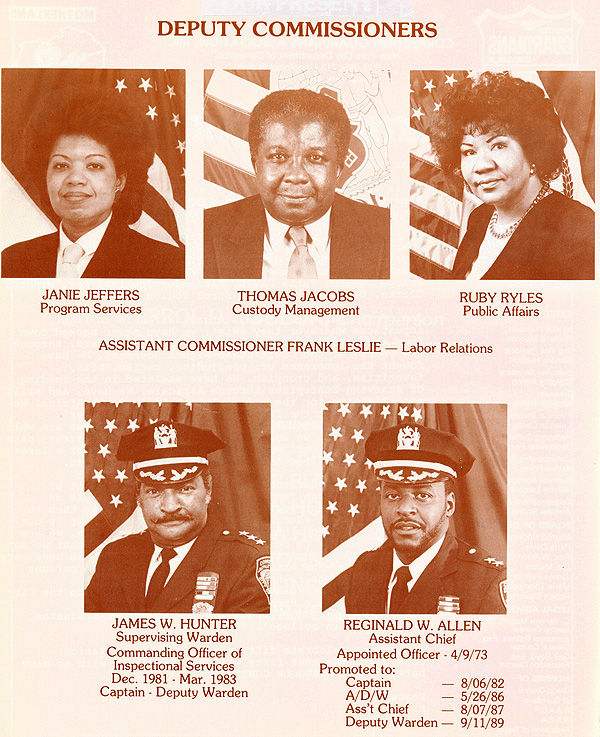 1st Deputy Commissioner Dina Simon's Appointment: A Tri-Focus Bridge Connecting Black and Women's History Months and DOC FDC History Focusing the CorrectionHistory.Org website spotlight on the recently-appointed NYC Department of Correction (DOC) First Deputy Commissioner, Dina Simon, serves well to connect both 2016's Black History Month (February) and Women's History Month (March). It also provides opportunity to look into the history of the First Deputy Commissioner (FDC) position itself.
When these historic "firsts" are pointed out to her, Ms. Simon -- who came to the U.S. from her native Haiti at age 9 and grew up in Brooklyn and later eastward on Long Island -- is wont to add proudly "and the first Caribbean FDC too." She does so, flashing a winning smile. Some Black Commissioners, Deputy A number of men and women of African-American heritage have served as DOC Commissioners, Deputy Commissioners and Assistant Deputy Commissioners. The 1989 72-page glossy souvenir journal, celebrating the 50th anniversary of the NYC Correction Guardians, lists some early ones, including
Also cited in the Correction Guardians' journal were
Deputy Commissioners and Assistant Deputy Commissioners mentioned included
During brief periods when the First Deputy Commissioner is away, such as on personal holiday or a few days illness, a Deputy Commissioner sometimes is designated to function as the FDC temporarily. But that's without formal appointment as Acting FDC in pay title.
But during those transitory stints in that capacity, they remained DCs on DOC's employment rolls. Not intending to diminish in any way the efficacy of the important services which they rendered in that role, one might nevertheless say, figuratively speaking, each was an "acting FDC" with a small "a." Ms. Simon's appointment in October 2015 as Acting FDC came with a cap "A" from the get-go. The "Acting" was dropped from her title the first week of 2016. By the way, extensive excerpts from the DOC Correction Guardians' 50th anniversary journal can be accessed from the CorrectionHistory.Org website, thanks to Monroe College Professor Errol D. Toulon making a copy available for that purpose some years ago. A former Correction Academy Deputy Warden, Toulon had been, among many other distinctions, also a COBA first vice president. And oh, yes, he is the father of the current DOC Deputy Commissioner of Operations, Dr. Errol D. Toulon Jr., himself like his dad, a veteran of decades of DOC uniformed service.
She joined DOC in 2014 as the Deputy Commissioner of Human Resources. Prior to coming to DOC, she served as Director of Human Resources for the Office of the NYC Comptroller. Ms. Simon's work background in human resources and labor relations includes positions with the NYS Education Department, NYS Office of Developmental Disabilities, Norfolk State University, and the Navy Exchange Service Command Center. She holds a Master's in Public Administration from Long Island University, C.W. Post and a Bachelor's of Science from SUNY Brockport. Ms. Simon succeeded James E. Dzurenda who resigned in October 2015. At one point in her professional career, she engaged in travel services with strong social and civic features. The Haitian Roundtable, a group of Haitian-American professionals engaged in civic and philanthropic endeavors to benefit the people of that struggling Caribbean island nation, has reported: "With Haiti in her heart, [Ms. Dina Simon] founded the My Haiti Travels agency shortly following the devastating earthquake of January 2010 to support the resurgence of tourism and investment in Haiti, and to promote the patronage of local businesses, hotel and resort establishments and restaurants."
Koehler returned to DOC in September 1986 to become Commissioner, succeeding McMickens. Later, he helped establish a law firm which for many years has represented correction-related and other unions and their leaderships. Of the 30 or so men who have served as FDCs in the 120 years since DOC emerged from the Department of Public Charities and Correction as a separate municipal agency, Koehler is among the six who eventually received appointment to the top post. The other five and their relevant dates are:
Some other FDCs served as interim Commissioners during periods -- ranging from weeks to months -- between the departure of one Commissioner and the appointment of a successor. These interim Commissioners -- a few of whom even received the formal title of Acting Commissioner -- included
The earliest DOC formal usages of the term First Deputy Commissioner which this website's research has so far been able to find occurred in the 1930s with telegrapher - turned - publisher - turned - Tammany politican - turned - civil servant, Richard Lee Tudor. DOC did not start out having a Deputy Commissioner, much less a First Deputy Commissioner.
Under terms of the law mandating the Jan. 1, 1896 start for new and separate departments for Public Charities and Correction, Mayor William L. Strong had until Dec. 21, 1895, to name his appointees to run the two emerging departments. He did so 11 A.M., Dec. 21, by designating Wright to head Correction as a single Commissioner and named three Commissioners for Public Charities. Wright had been Mayor Strong's appointee to the old combined Charities and Correction board and was already familiar with Correction operations. His background was business; his politics, Republican. Apparently he considered having a Deputy Commissioner would be unnecessary and not having one would be frugality. But his successor, Francis J. Lantry, had a decidedly different personal style and background, and faced a different situation. He was DOC's first commissioner after New York changed from a one-county city into a multi-county city in 1898. Lantry had not one but two Deputy Commissioners: one just for the boroughs of Brooklyn and Queens, and one with five-borough jurisdiction.
For Lantry seems have been the consummate politician from youth. Apprenticed as a butcher's helper, he became active in the trade union movement, rising through the organizational structure to the high rank of Master Workman in his local Knights of Labor's assembly and for years served as its representative to the powerful District Assembly 49 in NYC. DA 49's contingent to the 1886 K of L's national convention in Richmond, Va., kicked up a social storm
At the time, Lantry was about 27, had been employed in the NYC meat industry since age 19, and much involved in DA 49 Knights of Labor activities. Regardless of whether Lantry was actually member of that trail-blazing DA 49 national contingent himself (a conceivable and interesting possibility), its high visibility and vitality as an activist labor organization was very much part of the political environment which helped shape his character and propel him to seek public office. In 1892, he ran for Alderman as a Tammany Democratic candidate and was narrowly elected. Re-nominated in 1894, he was elected, again narrowly. The district pre-Lantry had been consistently Republican. Lantry was Tammany Hall leader for the district, home to Robert Van Wyck, the first mayor of 5-borough Greater New York.
Those appear the earliest DOC usages of the FDC title, at least so far as this website has come up with, but research continues. We may yet find an earlier DOC use of the term. Often first usages will be found in newspapers, almanacs, and directories of the day. Then (as today) those publications were less constrained by considerations of salary grades or political and personal sensitivities when "assigning" job titles, rankings or standings to government officials. While their job title references may initially have been unofficial and informal, the colloquial frequently has dominated and become official parlance. Incidentally Tudor is also believed to be the FDC to serve longest as an Acting Commissioner, eight (8) months, this taking place between Sept. 27, 1932, when Commissioner Richard C. Patterson (who had overseen the start of Rikers Penitentiary construction) left to May 25, 1933 when the William J. Cahill was named successor to head DOC by Mayor John P. O'Brien. Prior to his long career in Correction, which spanned from 1918 to 1934, Tudor had first been employed on railroads as telegrapher and station/ticket agent, and later as publishing house rep. He entered Tammany Hall politics in the early 20th Century, eventually becoming president of the Tammany Central Club of the 14th Assembly District which he represented in a Albany as an Assemblyman for four years before accepting appointment, first as Secretary to the Commissioner and then as Deputy Commissioner. When an Assemblyman, Tudor succeeded getting passed and signed in law his bill -- daringly enlightened for its era -- requiring that whenever a physical exam would be a condition of employment, the employer must provide a prospective female employee the option and opportunity to be examined by a female doctor.
|









